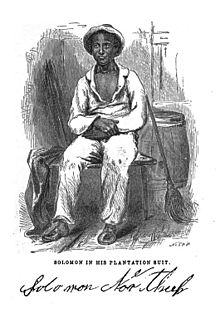
Back عبد لاثني عشر عاما (كتاب) Arabic Twelve Years a Slave German 12 años de esclavitud (libro) Spanish 12 vuotta orjana Finnish Douze ans d'esclavage French Duodece Annos Sclavo Interlingua Twelve Years a Slave ID 12 anni schiavo (libro) Italian 노예 12년 (책) Korean ਬਾਰਾਂ ਸਾਲ ਗ਼ੁਲਾਮੀ Punjabi
 Illustration from Twelve Years a Slave (1855) | |
| Author | David Wilson |
|---|---|
| Country | United States |
| Language | English |
| Genre | Autobiography, slave narrative |
| Publisher | Derby & Miller, Auburn, New York[1] |
Publication date | 1853[2] |
| Media type | Print (hardcover) |
| ISBN | 978-1843914716 |
| 301.45 | |
| Text | Twelve Years a Slave at Wikisource |
Twelve Years a Slave is an 1853 memoir and slave narrative by Solomon Northup as told to and written by David Wilson. Northup, a black man who was born free in New York state, details himself being tricked to go to Washington, D.C., where he was kidnapped and sold into slavery in the Deep South. He was in bondage for 12 years in Louisiana before he was able to secretly get information to friends and family in New York, who in turn secured his release with the aid of the state. Northup's account provides extensive details on the slave markets in Washington, D.C., and New Orleans, and describes at length cotton and sugar cultivation and slave treatment on major plantations in Louisiana.
The work was published by Derby & Miller of Auburn, New York[1] eight years before the American Civil War and soon after Harriet Beecher Stowe's best-selling novel about slavery, Uncle Tom's Cabin (1852), to which Northup's book lent factual support. Northup's book, dedicated to Stowe, sold 30,000 copies, making it a bestseller in its own right.[3]
Although the memoir was published in several editions in the 19th century and later cited by scholarly works on slavery in the United States, it fell into public obscurity for nearly 100 years. It was re-discovered on separate occasions by two Louisiana historians, Sue Eakin (Louisiana State University at Alexandria) and Joseph Logsdon (University of New Orleans).[4] In the early 1960s, they researched and retraced Solomon Northup's journey[5] and co-edited a historically annotated version that was published by Louisiana State University Press (1968).[6]
The memoir has been adapted as two film versions, produced as the 1984 PBS television film Solomon Northup's Odyssey and the 2013 film 12 Years a Slave, which won multiple Oscars including Best Picture.[7]
- ^ a b J.C. Derby (1884), "William H. Seward", Fifty Years Among Authors, Books and Publishers, New York: G.W. Carleton & Co., pp. 62–63
- ^ The Picayune, 6 February 1853, p. 6
- ^ Northup, Solomon. Twelve Years a Slave: Summary, online text at Documenting the American South, University of North Carolina, accessed 19 July 2012
- ^ "'12 Years a Slave' prompts effort to recognize work of UNO historian in reviving tale". Nola.com. Retrieved 27 September 2013.
- ^ Cieply, Michael (23 September 2013). "An Escape From Slavery, Now a Movie, Has Long Intrigued Historians". The New York Times. Retrieved 26 September 2013.
- ^ "Twelve Years A Slave by Solomon Northup". Lsupress.org. Retrieved 26 September 2013.
- ^ Cieply, Michael; Barnesmarch, Brooks (2 March 2014). "'12 Years a Slave' Claims Best Picture Oscar". The New York Times.
© MMXXIII Rich X Search. We shall prevail. All rights reserved. Rich X Search